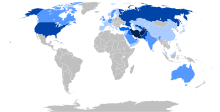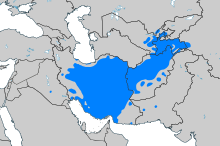Tataramon na Persa
| Persian | |
|---|---|
| فارسی (fārsi), форсӣ (forsī) | |
 Fārsi written in Persian calligraphy (Nastaʿlīq) | |
| Pagsayod | [fɒːɾˈsiː] ( |
| Subong sa |
|
Subong na mga parataram | 70 million[7] (110 million total speakers)[6] |
Indo-European
| |
Mga amay na porma | Old Persian
|
Mga Pormang Estandarte | |
| Mga Diyalekto | |
Plantilya:Startplainlist
| |
| Opisyal na kamugtakan | |
Opisyal na tataramon sa |
|
| Sa regulasyon kan | Plantilya:Startplainlist
|
| Mga kodigo nin tataramon | |
| ISO 639-1 | fa |
| ISO 639-2 | per (B) fas (T) |
| ISO 639-3 | fas – inklusibong kodigoIndibiduwal na mga kodigo: pes – Iranian Persianprs – Daritgk – Tajik languageaiq – Aimaq dialectbhh – Bukhori dialecthaz – Hazaragi dialectjpr – Judeo-Persianphv – Pahlavanideh – Dehwarijdt – Judeo-Tatttt – Caucasian Tat |
| Glotologo | fars1254 |
 Persian Linguasphere. Legend Official language More than 1,000,000 speakers Between 500,000 – 1,000,000 speakers Between 100,000 – 500,000 speakers Between 25,000 – 100,000 speakers Fewer than 25,000 speakers / none | |
| Linguaspero | |
 Areas with significant numbers of people whose first language is Persian (including dialects) | |
 Persian Linguasphere. Legend Official language More than 1,000,000 speakers Between 500,000 – 1,000,000 speakers Between 100,000 – 500,000 speakers Between 25,000 – 100,000 speakers Fewer than 25,000 speakers / none | |
An persa o farsi (sa persa: فارسی fârsí) sarong tataramon na opisyal tinataram sa Iran, Afghanistan asin Tajikistan asin sa ibang rona' kan Uzbekistán,[10] asin dai ibali sa bilang idtong mga persa na yaon nawawarak sa bilog na kinaban. Igwang sobra sa 100 milyon na parataram na katutubo kaini.
An pangaran kan taramon na ini "persa" sa luwas kan tinuboan na lugar kaini alagad ini midbid sa tal asin natibong pangaran kaini na farsi.[11]. An katagang "farsi" iyo an aktwal na designasyon kan tataramon na ini sa laog kan Iran.
An Persa sarong tataramon na Iranong solnopan napipisan sa sangang Irano kan Indo-Iranong subdibisyon nin Indo-Europeong mga tataramon. An Persa predominanteng opisyal na tinataram sa laog kan Iran, Afghanistan asin Tajikistan sa tolong nagkakasinabotan na estandarteng barayti, na iyo an mga minasunod Iranian Persian (opisyal na midbid komo Persa),[12][13][14] Afghan Persian (opisyal na midbid bilang Dari poon pa kan 1964)[15] asin an Tajiki Persian (opisyal na apod Tajik poon pa kan 1999).
An lenggwaheng Persa opisyal nasusurat sa alpabetong Persa sa laog kan Iran asin Afghanistan, na ini guminikan mansana sa eskriturang Arabo, asin sa laog kan Tajikistan an gamit alpabetong Tajik, na gikan mansana sa eskriturang Cyrillic.
Toltolan
[baguhon | baguhon an source]- ↑ 1.0 1.1 1.2 Samadi, Habibeh; Nick Perkins (2012). Martin Ball; David Crystal; Paul Fletcher, eds. Assessing Grammar: The Languages of Lars. Multilingual Matters. p. 169. ISBN 978-1-84769-637-3.
- ↑ "IRAQ". Encyclopædia Iranica. Retrieved 7 November 2014.
- ↑ "Tajiks in Turkmenistan". People Groups.
- ↑ Pilkington, Hilary; Yemelianova, Galina (2004). Islam in Post-Soviet Russia. Taylor & Francis. p. 27. ISBN 978-0-203-21769-6.
Among other indigenous peoples of Iranian origin were the Tats, the Talishes and the Kurds.
- ↑ Mastyugina, Tatiana; Perepelkin, Lev (1996). An Ethnic History of Russia: Pre-revolutionary Times to the Present. Greenwood Publishing Group. p. 80. ISBN 978-0-313-29315-3.
The Iranian Peoples (Ossetians, Tajiks, Tats, Mountain Judaists)
- ↑ 6.0 6.1 6.2 6.3 6.4 Windfuhr, Gernot: The Iranian Languages, Routledge 2009, p. 418.
- ↑ "Persian | Department of Asian Studies" (in English). Retrieved 2 January 2019.
There are numerous reasons to study Persian: for one thing, Persian is an important language of the Middle East and Central Asia, spoken by approximately 70 million native speakers and roughly 110 million people worldwide.
- ↑ Constitution of the Islamic Republic of Iran: Chapter II, Article 15: "The official language and script of Iran, the lingua franca of its people, is Persian. Official documents, correspondence, and texts, as well as text-books, must be in this language and script. However, the use of regional and tribal languages in the press and mass media, as well as for teaching of their literature in schools, is allowed in addition to Persian."
- ↑ Constitution of the Republic of Dagestan: Chapter I, Article 11: "The state languages of the Republic of Dagestan are Russian and the languages of the peoples of Dagestan."
- ↑ T. M. Masti︠u︡gina, Lev Perepelkin, Vitaliĭ Vi͡a︡cheslavovich Naumkin, "An Ethnic History of Russia: Pre-Revolutionary Times to the Present", Greenwood Publishing Group, 1996. p. 80: "The Iranian Peoples (Ossetians, Tajiks, Tats, Mountain Judaists)"
- ↑ Diccionario de la lengua española: definición de "persa"
- ↑ "Persian, Iranian". Ethnologue. Retrieved 25 February 2021.
- ↑ "639 Identifier Documentation: fas". Sil.org. Retrieved 25 February 2021.
- ↑ "The Constitution of the Islamic Republic of Iran". Islamic Parliament of Iran. Archived from the original on 27 October 2016. Retrieved 18 January 2022.
- ↑ Olesen, Asta (1995). Islam and Politics in Afghanistan. 3. Psychology Press. p. 205.
There began a general promotion of the Pashto language at the expense of Farsi – previously dominant in the educational and administrative system (...) — and the term 'Dari' for the Afghan version of Farsi came into common use, being officially adopted in 1958.
